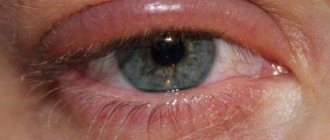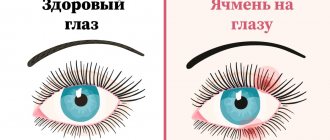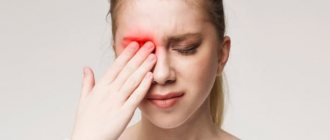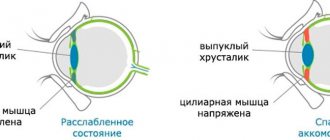Meibomitis is an ophthalmic disease in which the meibomian glands become inflamed. They are located in the thickness of the cartilage of the upper and lower eyelids. The disease is polyetiological. This means that there are many reasons for the development of meibomitis. Let's take a closer look at the factors that provoke this inflammation, symptoms and methods of treating it.
Meibomian glands are modified sebaceous glands that are located on the edges of the eyelids, in the thickness of the cartilage. They were discovered by Heinrich Meibom, after whom they were later named. The glands consist of alveoli. They secrete a fatty secretion that lubricates the eyelids and protects them from wetting by tear fluid, which protects the eyes from drying out. There are approximately 20-30 alveoli in the lower eyelids, and 30-40 in the upper eyelids. Inflammation of the meibomian glands is called meibomitis, which can affect the upper and lower eyelids, one or both eyes. What causes it?
Causes of meibomite
The immediate causes of meibomitis are identified - causative agents of inflammation, as well as triggers - provoking factors. Often the disease occurs when bacteria enter the meibomian glands, predominantly Staphylococcus aureus. The cause of the inflammatory process can be pneumococci, streptococci and other bacteria, as well as mycoses, mites, and viruses. Conditions predisposing to meibomite should be considered:
- hypothermia of the body;
- failure to comply with hygiene rules, including when wearing contact lenses;
- respiratory infection;
- eyeball injury;
- other eye infectious diseases;
- poor nutrition, vitamin deficiency, weak immunity.
Pathogenic microorganisms and viruses enter the glands through the mouth of the excretory duct when scratching the eyelids with fingers or a handkerchief. You can also get infected with contact optics that have been poorly treated with a cleaning and disinfection solution.
Causes
The main cause of the development of meibomitis is coccal pyogenic infection, mainly bacteria of the genus Staphylococcus . In favorable conditions of the eye, a staphylococcal infection finds a nutrient medium and begins to develop at tremendous speed, increasing in quantity, which causes the body to respond - activation of the body’s defenses:
- fever and antibody ;
- immune cells - leukocytes to the site of inflammation, absorption of foreign microorganisms, death with the formation of pus .
Symptoms of meibomite
The symptoms of the disease depend on the form of its course and the cause that caused it. Acute inflammation is characterized by severe symptoms. Such meibomitis is accompanied by an increase in body temperature and general malaise. Ophthalmological signs are as follows:
- redness and thickening of the eyelid due to increased blood flow at the site of inflammation;
- local flow;
- painful sensations in the eyelids;
- increased lacrimation;
- there is a translucent yellow formation inside the tissue, it is visible when the eyelids are turned outward.
Infiltrates resolve after a few days, and spontaneous opening occurs less often. The contents of the formation exit through the excretory duct of the gland.
Chronic inflammation is characterized by the formation of a chalazion, a benign lump in the cartilage of the eyelid. It is usually not painful and rarely opens. However, the danger of this course of the disease is that it can lead to the development of conjunctivitis and other ophthalmic pathologies, including impaired visual function. Chronic meibomitis in most cases occurs with very weak immunity, and also as a complication of the acute form of the disease. In addition to the formed hailstones, a person may be bothered by symptoms such as:
- tearfulness;
- blurred vision;
- thickening of the eyelids with slight redness;
- formation of yellow plaque in the corners of the eyes.
In rare cases, several hailstones are formed. They also represent a noticeable cosmetic defect. Inflammation can occur on both the upper and lower eyelids. Often pathology develops in only one eye. Meibomitis of the lower eyelid and meibomitis of the upper eyelid are accompanied by the same symptoms.
Symptoms
Manifestations of both acute and chronic meibomitis are usually local in nature and are exclusively an ophthalmological problem. Internal styes can only be seen when the eyelid is everted and:
- a yellowish pustule is visible through the mucous membranes - a source of inflammation;
- the conjunctiva is red and swollen;
- infiltration and swelling are observed, regional lymph nodes, for example, parotid ones, may be enlarged;
- as a result of the increased work of the meibomian glands, yellowish-gray crusts can be found in the corners of the eyelid.
The focus of meibomitis with an inverted eyelid
Diagnosis of meibomite
During the examination, the doctor must determine the cause of the disease. The method of treatment and the type of medications that will be used depend on it. So, for bacterial etiology, antibiotics and antibacterial agents are prescribed, for fungal infections of the eyelids, antifungal drops and ointments are used, etc. The following methods allow you to make an accurate diagnosis:
- microscopic and cultural studies of secretions;
- scraping analysis;
- slit lamp biomicroscopy;
- allergy tests;
- examination of eyelashes for demodicosis.
Diagnostics
The main task of an ophthalmologist is to distinguish meibomitis from other eye diseases with similar symptoms. Patients do not immediately seek advice because they believe that their eyes are simply tired and require rest. The alarm begins to sound only when purulent discharge and dried secretions appear on the eyelids.
Diagnosis of meibomitis is carried out using a slit lamp: it clearly shows dilated glands clogged with dried secretions. In the chronic form of the disease, the patient is prescribed additional diagnostics:
- allergen identification;
- for helminthiasis;
- on the pathogen;
- Demodex mite detection.
The main task of the doctor is to distinguish meibomite from barley.
How to distinguish meibomite from barley?
These diseases are sometimes confused; meibomitis is even called “internal stye.” However, they differ in a number of ways. Pathologies are treated using different methods, so it is necessary to differentiate them. Barley is an inflammation of the eyelash follicle, and meibomitis is an inflammatory process in the thickness of the cartilage of the eyelid. The first is localized on its edge, and the second - on the inside. The barley stem is clearly visible. To detect the purulent head of meibomite, you need to turn away the eyelid. When the meibomian glands become inflamed, the abscess matures slowly—a week or two. Barley is developing rapidly. A purulent formation becomes noticeable within a day or two after the onset of the inflammatory process.
Diagnostics using medical equipment will allow you to accurately make a diagnosis. You cannot self-medicate. Some people begin treatment for a stye without knowing that they are developing meibomitis. This can lead to complications.
Problems of the elderly. Eyelid diseases: diagnosis and treatment
| Figure 1. Entropion of the upper eyelid with cicatricial pemphigus |
What are the most effective methods to control the development of blepharitis? When to operate on patients with entropion and ectropion? What signs of eyelid tumors indicate their malignancy?
The main function of the eyelids is to protect the cornea from external influences. The eyelids also maintain a constant environment for the eye, including protecting the tear film necessary for the functioning of the cornea.
For adequate functioning of the eyelids, it is necessary to have eyelashes of a certain length and shape, normal tone of the eyelid muscles, and intact blink reflexes. If at least one of these components is impaired, the ability of the eyelids to perform their functions is also impaired, which leads to serious visual impairment and, possibly, blindness. The most common diseases of the eyelids in old age are caused by involutional changes associated with aging, the development of tumors (both benign and malignant) and systemic diseases.
- Blepharitis
Blepharitis, inflammation of the eyelids, is a very common disease that can only be controlled, but not cured. Patients usually complain of irritation, burning, and a sensation of a foreign body in the eyes. Symptoms are severe in the morning and decrease during the day. Clinically, blepharitis is distinguished between anterior (involving the edges of the eyelids) and posterior (mainly affecting the meibomian glands), although a combination of both is usually observed.
| Figure 2. With entropion, eyelashes scratch the cornea |
Anterior blepharitis requires eyelid care and topical antibiotics. Eyelashes are cleaned with diluted baby shampoo or soda (a quarter spoon of soda per cup of cool boiled water; only a freshly prepared solution is used). Eyelid toileting should be done regularly. Antibiotics are applied to the edge of the eyelid for a short time, immediately after the hygiene procedure.
Posterior blepharitis is corrected with hot compresses and eyelid massage (to facilitate the outflow of stagnant meibomian gland secretions).
The course of systemic antibiotics, such as tetracycline, doxycycline and erythromycin, for meibomitis ranges from 6 weeks to 6 months. Their mechanism of action is unknown; they are thought to stabilize lipid secretion.
- Entropion
This is a violation of the position of the eyelid, in which the edge of the eyelid is turned inward towards the eyeball. Recognizing the condition is important because rolled up eyelids and eyelashes can damage the cornea, leading to ulceration and secondary infection.
Table 1. Diseases of the eyelids in old age
| Bacterial infections, inflammation | |
| Barley | Infection of Zeiss glands |
| Chalazion | Meibomian gland infection/inflammation |
| Meibomite | Induration/inflammation of the meibomian glands |
| Blepharitis | Inflammation of the edge of the eyelid |
| Viral infections | |
| Herpes simplex | Vesicular rash |
| Herpes zoster | Rash and blisters along the trigeminal nerve |
| Viral warts | Thread-like damage |
| Molluscum contagiosum | Umbilical lesions |
| Trichiasis | Eyelashes point backward, usually due to scarring on the eyelids |
| Blepharoptosis (ptosis) | Weakening of the eyelids |
| Dermatochalasion | Excess eyelid skin |
| Blepharospasm | Involuntary tonic and spastic closure of both eyelids |
| Entropion | Turning up the edge of the eyelid |
| Ectropion | Everting of the eyelid edge |
| Benign tumors | |
| Papillomas | Warts, seborrheic keratosis, actinokeratosis |
| Keratoxanthoma | Ulcer filled with keratin surrounded by rapidly growing hyperplastic tissue |
| Xantellasma | Yellowish lipid plaques in the medial area of the eye |
| Nevi | Pigmented formations |
| Malignant tumors | |
| Basal cell carcinoma | Firm, raised granular nodules with central ulcerations |
| Squamous cell carcinoma | Tumors with an uneven surface, newly formed or arising in areas of sunburn |
| Sebaceous carcinoma | Extremely malignant tumor masquerading as a chalazion, chronic blepharitis, or basal cell carcinoma |
Involutional (senile) entropion is caused by degenerative changes in the structure of the eyelid. These include horizontal weakness of the eyelid and/or canthus tendons, weakening of the eyelid retractors and orbital muscles, and atrophy of orbital tissue. Senile entropion usually affects the lower eyelids. The patient complains of irritation and soreness of the eyes; they may become red and inflamed. Sometimes clouding occurs in those places of the cornea that are damaged by eyelashes.
Treatment is carried out only in the presence of clinical symptoms and is most often surgical. It is aimed at restoring the function of weakened muscles that contract the eyelid. Temporarily, while awaiting surgical intervention, they resort to lubricating the cornea, as well as attaching adhesive tape under the lower edge of the eyelid (to prevent it from turning in).
Cicatricial entropion is associated with shortening and curvature of the posterior plate of the eyelid. The reason for this may be various autoimmune disorders (cicatricial pemphigus), inflammatory disorders, infections (trachoma, herpes), surgical interventions (enucleation), injuries (thermal, chemical, thermal).
It is more difficult to treat cicatricial entropion than involutional entropion. The goal is to eliminate chronic irritation of the eye through local lubrication, removal of eyelashes and keratinized areas, treatment of the underlying disease, surgical rotation of the eyelid along with the mucous membrane, and transplantation of other tissues (to replace damaged scar tissue of cartilage and conjunctiva).
- Ectropion
Ectropion is an abnormal position of the eyelid in which the edge of the eyelid turns outward from the eyeball. The lower eyelid is affected much more often than the upper eyelid. This condition can lead to keratopathies, conjunctival hypertrophy and lacrimation.
| Figure 3. Blepharitis is very common; it cannot be cured, but its development can be controlled |
Involutional ectropion, the most common cause of watery eyes, is caused by weakening of the muscles that contract the lower eyelid and the tendon of the corner of the eye. Treatment includes horizontal shortening of the eyelid size and tightening of the tendons; carried out when lacrimation or keratopathy develops.
Cicatricial ectropion is caused by scarring combined with stretching of the skin. Damage around the eyes and subsequent scarring can contribute to the formation of ectropion. To avoid this, it is necessary to place the scars parallel, and not perpendicular to the edge of the eyelid. Treatment consists of relaxing operations and tissue transplants.
Table 2. Types of blepharitis and their clinical manifestations
| Staphylococcal | Seborrheic | Meibomian | |
| Symptoms | Burning and itching | Burning and itching | Burning and irritation |
| Scales | Hard, brittle | Greasy | Greasy |
| Meibomian glands | Not changed | Changed (viscous plugs and swollen orifices) | Changed |
| Ulceration | Eat | No | No |
| Keratitis | Marginal superficial punctate keratopathy (MSP) | PTK | PTK |
| Hordeola | Styes often occur | Rarely | Chalazions are common |
| Conjunctivitis | Always | Occasionally | Always |
| Treatment | Eyelid hygiene, topical antibiotics | Eyelid hygiene, dermatitis treatment | Eyelid hygiene, hot compresses, systemic antibiotics |
| Note: PTC - superficial punctate keratopathy | |||
Paralytic ectropion develops as a result of damage to the seventh pair of cranial nerves, which leads to weakening of the lower eyelid, incomplete closure of the eyelids and infrequent blinking. The cornea becomes irritated and dry.
For treatment, ointments are applied topically and the temporal part of the lower eyelid is temporarily immobilized. To permanently immobilize the lower eyelid, surgery is performed - lateral tarsorrhaphy - or a loop is formed to support the lower eyelid.
In trichiasis, the eyelashes are usually directed towards the surface of the eye, which is often accompanied by chronic blepharoconjunctivitis or cicatricial conjunctivitis. Treatment includes mechanical epilation, electrolysis and cryotherapy to break up and remove the offending eyelashes, or surgery to retract the eyelashes away from the eyeball.
- Tumors of the eyelids
The first thing to do when a tumor of the eyelid is detected is to find out whether it is malignant. All excess tissue, except clearly inflamed tissue, is subject to histological examination. Malignancy is indicated by ulceration, induration, uneven surface, painless local telangiectasia, and irregular margins.
| Figure 4. Meibomite: eyelids look inflamed, red and thickened, there are few scales on the eyelashes |
Basal cell carcinomas (BCCs) account for more than 90% of malignant eyelid tumors. They usually affect the sun-exposed lower eyelids and the medial corner of the eye. Classic BCC is a nodule with an uneven surface, telangioecasias and a rounded edge, with a central ulceration.
Treatment is complete removal of the tumor, confirmed histologically. Radiotherapy and cryotherapy remain alternative methods, but the high relapse rate limits their use.
Squamous cell carcinoma (SCC) is much less common than BCC but is significantly more malignant. It can occur spontaneously or in areas of sunburn and radiation keratosis. The tumor is amenable to cryotherapy and radiation, but the method of choice remains surgery with histological control of the tissue around the tumor. In case of recurrent PCI, more traumatic operations are required - with complete removal of the orbital contents.
Sebaceous adenocarcinoma is very rare and requires careful diagnosis. This is an extremely malignant tumor, usually fatal, arising from the meibomian glands on the cartilage of the eyelid or from the glands of Zeiss.
These tumors can “masquerade” as benign conditions, such as chronic blepharitis and chalazion. Any atypical manifestations or resistance to treatment should suggest a malignant process. Diagnosis is usually made by biopsy of a full-thickness section of the eyelid.
References
1.
Woog JJ, Jakobiec FA Principles and Practice of ophthalmology - clinical practice.
WB Saunders Co. Vol. 3 8: 1685-1859. 2.
Arffa, RC Grayson's diseases of the cornea.
Mosby Year Book Inc, 1991 13: 295-309. 3.
Tasman W., Jaeger E. A. Duanes' clinical ophthalmology. Vol. 6 118, 123
Note!
- Anterior blepharitis can be controlled with eyelid hygiene—cleaning the eyelid margins with diluted baby shampoo or sodium bicarbonate solution—and applying topical antibiotics to the eyelid margin after cleaning
- For posterior blepharitis, hot compresses and eyelid massage are used (to facilitate the passage of stagnant meibomian gland secretions) and systemic antibiotics are prescribed, such as tetracycline, doxycycline and erythromycin
- With entropion, a rolled-up eyelid can damage the cornea, causing ulceration and secondary infection. Treatment is usually surgical, aimed at restoring elasticity and reducing laxity of the eyelid.
- The first step in treating eyelid tumors is to determine their malignancy. Signs of malignancy: ulceration, induration, uneven surface, painless local telagioectasia and granular margins
Treatment of meibomitis
This pathology is treated with the help of medications, physiotherapeutic procedures and surgical methods. First of all, it is necessary to destroy the pathogenic microbes that caused the inflammation. We are talking about viruses, bacteria, mycoses, etc. In case of allergies, contact of the patient with the allergen should be excluded. Medicines used for meibomitis have a local effect. Eye drops and ointments are prescribed to be placed under the eyelids.
Typically, inflammation occurs due to bacteria entering the meibomian glands. In such cases, antibiotics are used in ointments - gentamicin and tetracycline. For very severe inflammation, hydrocortisone-based medications are prescribed. These drugs are a type of steroid medication that have many side effects. Systemic antibiotics for oral administration are needed for severe illness accompanied by an increase in body temperature.
Regardless of the nature of the disease, eyelid rinsing solutions are almost always used. You can make them from Furacilin. A similar procedure is carried out each time before instilling drops and applying ointments. In addition to Furacilin, fish oil is used. They lubricate the edges of the eyelids. This allows you to gently remove crusts and pus.
Causes and symptoms of the disease
The aggressive agent that causes this type of inflammation is Staphylococcus aureus. However, the disease can be caused by pneumococci along with streptococci. Bacteria easily penetrate the tissues of the visual organs when scratching the eyelids with unwashed hands instead of a handkerchief or with a dirty handkerchief. The symptoms of the disease do not depend on the type of pathogen; they manifest themselves in the same way - inflammation, redness, suppuration.
Inflammation of the meibomian glands is a disease beyond age. It affects infants, elderly people, schoolchildren, and middle-aged people. Young girls are most susceptible to infection due to improper use of cosmetics and insufficient eye hygiene. Those who constantly wear contact lenses are susceptible to pathology.
Children of school and preschool age often acquire coccal infection from dirty hands by rubbing their eyes with their fingers. In old age, infection easily penetrates the visual organs due to a decrease in the body's protective functions. In men, meibomitis is rarely diagnosed.
Provoking factors for the development of pathology:
- being in drafts;
- clothes out of season;
- failure to comply with personal hygiene rules;
- low immunity, frequent colds;
- monotonous diet, lack of vitamins;
- injury to the conjunctiva with contact lenses;
- any ophthalmological diseases.
Meibomite can appear due to acne and inflammatory skin diseases.
Meibomitis sometimes appears as a complication of stye or blepharitis, so any ophthalmological diseases should be cured completely.
Symptoms of pathology:
- heaviness in the eyelids;
- swelling and redness of the eyelid;
- burning sensation, itching;
- a feeling of sand that interferes with blinking;
- sticking of eyelashes after sleep.
Subjective sensations during inflammation are the same for everyone. Pain in the eyes when blinking, interfering sand, discomfort and decreased quality of vision. In the morning, it is difficult to open the eyes due to the glued eyelashes; you have to remove the dried secretion with a swab soaked in a sterile solution.
General principles of drug treatment of acute meibomitis
This form of inflammation develops quickly. Treatment must be started immediately, otherwise the risk of the disease becoming chronic increases. When treating an acute inflammatory process you should:
- prohibit various lotions and compresses from decoctions;
- use dry heat;
- apply physiotherapeutic methods;
- lubricate the affected area of the eyelid with an alcohol solution of 70% up to three times a day;
- instill eye drops at least three times a day;
- refuse eye baths;
- apply ointments before going to bed.
Treatment of the upper and lower eyelids is carried out using the same methods using the same drugs.
Meibomite drops
To treat meibomitis, antibacterial drops are prescribed:
- Digital
1-2 drops are instilled into the conjunctival sac every four hours. In the acute form, you can drip once an hour, but after the condition has improved, the intervals between doses are increased. Duration of treatment is from ten days to four weeks. The medication is not prescribed for pregnancy, breastfeeding, children under 15 years of age, or high sensitivity to the components of the drug. - Gentamicin.
The drug is instilled 3-4 times a day, 2 drops into the lower conjunctival sac of the eye. The drug is contraindicated in pregnancy, breastfeeding, high sensitivity to the drug, kidney disease, acoustic neuritis, uremia. The medicine can be used to treat children.
The doctor may also prescribe Tobradex, Ciprofloxacin, Dancil and other drugs.
Physiotherapy for meibomitis
Positive dynamics are observed in the treatment of inflammation using hardware methods. As a rule, a course of UHF therapy or ultraviolet irradiation aimed at the eyelids is prescribed. In recent years, procedures such as:
- Helium-neon laser stimulation. Therapy using laser technology has analgesic, anti-inflammatory and regenerative effects. Opened ulcers heal faster. The risk of complications is reduced.
- Magnetotherapy. Magnetic fields directed to the eyelids by a special device help restore natural biorhythms in the tissues, normalizing their condition. After just a few sessions, the functionality of the meibomian glands improves.
Massage and physiotherapy
To completely clear the meibomian ducts, conservative treatment must be assisted by massage. Gentle finger movements will help the ducts clear of internal contents and function in a healthy manner. The massage is carried out using painkillers and instruments. When massaging, it is important to squeeze out dried secretions from the ducts. To avoid introducing dirt into the tissue, the edges of the eyelids are disinfected before the massage.
It is strictly prohibited to squeeze dried secretions out of the ducts on your own.
Physiotherapeutic procedures help speed up the release of the ducts and recovery. For meibomitis, UHF and ultraviolet lamp irradiation are prescribed. Dry heat also helps the abscess to ripen and open faster.
In addition to traditional physiotherapy, new methods of influencing an abscess have recently been widely used:
- laser stimulation;
- magnetotherapy.
What is laser stimulation? Helium-neon laser stimulation activates the dynamics of blood supply in the affected area, and nutrients are supplied to the tissues along with the blood. Laser stimulation also activates all physiological processes in the eye tissues and restores healthy processes at the cellular level. As a result, the affected area is quickly restored and begins to function actively.
Magnetic therapy is widely used in ophthalmology. Magnetic fields help restore natural biorhythms, resulting in regeneration of affected tissues.
Surgical treatment of meibomitis
If the abscess does not open spontaneously and increases in size, conservative therapy does not bring results, then there is a need for surgical opening of the pathological formation. The operation is performed on an outpatient basis. There is no specific preparation for it. The procedure is performed under local anesthesia. The opening of the abscess is carried out from the side of the conjunctiva along the main excretory duct of the gland. Today, such operations are performed using a laser. If, after surgical treatment, granulations occur that interfere with tissue healing, surgical removal is also indicated.
Drug therapy
If the patient seeks medical help in time, meibomitis can be easily treated with classical methods of therapy at home. Treatment consists of:
- the use of drops and eye ointments;
- thorough sanitation of the eyelids with antiseptic solutions;
- strengthening the immune system.
At the very beginning of the onset of symptoms, it will be enough to use ordinary brilliant green - it is used to burn the edge of the inflamed eyelid. Together with brilliant green, the well-known Albucid ophthalmic drops are used.
During treatment for meibomitis, it is prohibited to use decorative cosmetics or wear contact lenses.
Before any medical manipulations, it is necessary to carefully prepare the eyelid - rinse, disinfect, and dry. But first you need to remove the dried secretion. To do this, carefully lubricate the edges of the eyelids with fish oil (dip a cotton swab into the substance). After this, dried crusts are easily removed from the eyelids.
Then the eyelids should be disinfected with an antiseptic: furatsilin solution is suitable for this. When the eyelids are dry, you can apply the ointment prescribed by the ophthalmologist:
- hydrocortisone;
- methyluracil;
- oletethrine.
Time-tested tetracycline ointment and gentamicin emulsion cope well with inflammatory purulent processes.
Many medications are contraindicated for pregnant women. Uncontrolled use of medications in the early stages of pregnancy is especially dangerous.
A pregnant woman should promptly notify the ophthalmologist about her condition so that the doctor can select alternatives to potent antibiotics. These can be homeopathic medicines or traditional methods of therapy.
It is recommended to alternate the use of ointments with instillation of ophthalmic solutions:
- penicillin;
- zinc sulfate;
- dexamethasone;
- erythromycin;
- others.
If the disease is accompanied by an increase in temperature, in addition to local therapy, internal antibiotic and antipyretic tablets are prescribed. Perhaps the body's reaction shows increased bacterial activity.
Does eyelid massage help with meibomitis?
If the meibomian glands are inflamed, you can do a light eyelid massage. It is carried out with special sticks, which are sold in pharmacies. This procedure helps remove secretions, relieve redness and other signs of the disease. Before the massage, it is recommended to drop an anesthetic into the eyes. Do not start doing this without your doctor's approval. He must show how the procedure is carried out correctly. It is advisable to do it daily in the ophthalmologist's office. In this case, under no circumstances should you open the abscess yourself. This can lead to infection of other structures of the eye and other complications.
Disease prevention
The best preventative measure to prevent meibomitis is clean eyelids. In other words, maintaining and regular hygiene of the visual organs sharply reduces the likelihood of inflammation of the sebaceous glands. Of course, touching your eyes with dirty hands (for example, to remove a speck of dirt or for self-massage when your eyes are tired) is completely unacceptable - this is fraught not only with meibomitis, but also with a number of serious diseases. In hazardous industries and in unfavorable climates, it is imperative to use personal eye protection.
It is also necessary to avoid hypothermia and, conversely, overheating, monitor the general condition of the visual organs (for example, if necessary, take measures to artificially moisturize the cornea, undergo a course of vitamin therapy and/or immunostimulation). If there is such a possibility, it is advisable from time to time to perform a special massage in the nearest ophthalmology office (not independently) to evacuate excess secretion of the meibomian glands.
Prognosis and complications
The prognosis for treatment of meibomitis is favorable in most cases. The disease is treated for approximately 10-14 days. The main thing is to follow all the doctor’s recommendations and not abandon therapy, even if the symptoms disappear. Due to late treatment or its complete absence, complications are possible:
- keratoconjunctivitis is an inflammatory disease of the conjunctiva and cornea;
- orbital cellulitis - inflammation of the tissue of the eyeball behind the orbital septum;
- panophthalmitis - purulent and total inflammatory lesion of the entire eye;
- thrombosis of orbital veins;
- intracerebral abscess;
- meningitis.
Meibomite rarely leads to such serious consequences. However, it’s not worth the risk, so at the first signs of pathology, consult a doctor.
Complications of the disease
Internal stye (like external stye) can often be accompanied by inflammation of nearby lymph nodes, swelling and hyperthermia, headache and general malaise. There are cases when the inflammatory process of the meibomin glands causes purulent inflammation of the orbit, thrombophlebitis of the orbital veins, thrombosis of the cavernous sinus, inflammation of the meninges and septicemia - dangerous conditions that can lead to death. Usually, this happens when trying to squeeze pus out of an abscess, because... the blood of the eyelids flows to the veins of the orbit, and then to the sinuses of the brain.
Sometimes several styes form at once, which merge into a single abscess. In this case, the likelihood of serious complications becomes much higher.
Prevention of meibomitis
How to prevent inflammation of the eyelids? The causes and provoking factors of this disease were previously listed. Based on them, it is possible to formulate rules that must be followed in order to prevent the development of meibomite. Among them:
- careful care of contact lenses;
- maintaining hygiene;
- a ban on swimming in reservoirs with water that does not meet sanitary and hygienic requirements;
- proper nutrition and taking vitamins;
- use of high-quality cosmetics;
- control blood sugar levels in diabetes;
- timely treatment of all diseases.
MagazinLinz.ru team
Diet for meibomitis
Diet for eyes, nutrition to improve vision
- Efficacy: therapeutic effect after 2 months
- Timing: constantly
- Cost of products: 1800-1900 rubles. in Week
Dietary nutrition excludes the consumption of fatty foods and dishes, confectionery, ice cream, chocolate and other products containing sugar.
The diet should be enriched as much as possible with immunostimulating and tonic foods, herbal, green or other teas with ginger, including:
- nuts;
- garlic and herbs;
- pepper, broccoli, radish;
- seafood;
- apples and citrus fruits.
Traditional therapy
How were our ancestors treated when there was no official medicine yet? They used natural remedies - herbs, roots, fruits and berries. Some methods of traditional treatment are also used in official medicine, and the use of herbs has become widespread as an addition to the main therapeutic regimen. Also, a base of herbal extracts and extracts is used in homeopathy.
To relieve the symptoms of meibomitis, apply a gauze swab soaked in yogurt. Fresh plantain leaves applied to the affected eye help speed up healing (they must be thoroughly rinsed to remove dust). Extreme methods of treatment include smearing the edge of the eyelid with garlic juice (this is prohibited for children).
Bottom line
Meibomitis of the eyelids is a common disease that affects patients from infancy to old age. It is a disease of dirty hands, poor personal hygiene, as well as a weak immune system and poor nutrition. The disease is especially dangerous for young children who do not yet understand the importance of personal hygiene. At the first symptoms of eye disease, you should immediately go to an ophthalmologist. Only a doctor can distinguish meibomitis from barley; independent treatment of this pathology is fraught with the development of complications and transition to a chronic form.
Sources used:
- Ophthalmology. National leadership. - M.: GEOTAR-Media, 2014.
- S. N. Basinsky, E. A. Egorov. Clinical lectures on ophthalmology.
- Visual disability due to diabetes mellitus / E.S. Skorobogatova. - M.: Medicine, 2003.
- University of Nebraska Medical Center
Meibomite in children
How to treat infants and preschoolers for meibomitis if they resist procedures? Children are at risk for ophthalmological diseases because they do not follow precautions - they touch their eyes with unwashed hands, often catch colds, and suffer from helminthiasis. In weakened children, meibomitis occurs in a complicated form, often recurs, and can cause significant harm to health.
Meibomitis in children often results in various complications and is difficult to treat.
In children, the inflammatory process can quickly spread to adjacent healthy tissue, which will significantly complicate the healing process. Infection of the eyeball is especially dangerous. The difficulty in treating young children is that they do not understand the meaning of personal hygiene and touch their eyes with dirty hands. As a result, the infection does not go away from the child’s eyelids and provokes various complications.
During purulent inflammations, you should not walk in the wind; in cold weather it is better to stay at home. Protect your child from drafts.
How to clean dried crust from your eyes
An important rule is to take a separate cotton swab or cotton swab for each eye. This is to prevent infection from spreading from one eye to the other. The second rule is that all cleansing movements are from the outer corner of the eye to the inner. For simple eye hygiene, cooled boiled water is sufficient, but for diseased organs of vision it is better to use saline solution, furatsilin or herbal decoctions (carefully filtered through several layers of gauze).
Fresh tea leaves, prepared from natural tea leaves without aromatic or other additives, cleans and disinfects the eyes well. Regular Indian tea works well for these purposes. In the cooled tea leaves, you need to wet a cotton pad and carefully treat the child’s eyelids. You can dry your skin with a new cotton pad, but don’t put pressure on your eyes—just blot it.
Chamomile not only washes the eyes, but also helps relieve itching and eliminate inflammatory processes. Chamomile is suitable as a remedy, and also helps well as a prevention of inflammatory ophthalmological diseases.
To prepare an infusion of chamomile flowers, you need to brew 4 tsp of boiling water, cover and leave for 55-60 minutes. Be sure to strain the infusion thoroughly so that no small particles of the plant remain in it. Every day you should prepare a fresh solution to wash the child’s inflamed eyelids. For prevention, the eyes are washed in the morning and evening, during treatment - before each instillation.
A slightly pink solution of manganese is also used for washing. But this method is undesirable for children, because an undissolved manganese crystal may get caught and burn the mucous membrane. Instead of manganese, use a solution of furatsilin - it is safer. Also, furatsilin not only cleanses the eyes, but also fights coccal bacteria. It is better to buy a ready-made solution, but you can prepare it yourself from tablets.
What is prohibited:
- use untested means of treatment and disinfection;
- treat the child yourself without first consulting a doctor.
The pediatrician will teach the young mother the technique of washing the eyes and removing dried crusts from the child’s eyelids. There is nothing complicated about this, but you need to know the nuances.
How to instill the solution correctly
To drop the medicine into the baby's eyes, you need to use a pipette with rounded ends. Both eyes are instilled, even if one of them is healthy. When instilling, it is forbidden to touch the eyelids with the pipette or the tip of the bottle: infection can penetrate into the bottle of medicine.
The drops should be instilled not onto the pupil of the eye, but into the conjunctival sac. This is very important, since contact with the cornea can cause discomfort in the child. Also, before instillation, the bottle is warmed in your hands so that the warm solution gets into the child’s eye.
Once opened, the bottle should be stored on the side wall of the refrigerator.
To prevent the solution from leaking out of the eye, the child's head should be tilted back. Excess solution should be carefully blotted with a soft cloth or cotton pad.









